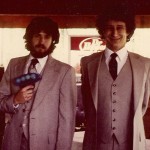An add to my post on Stuever’s ability to turn the minutiae of contemporary culture into fascinating repartee. One time Stuever and I had lunch in one of those $18-a-salad restaurants. We had some business to discuss, but I don’t remember what. What I remember is that we very quickly fell into what I always considered the real business of lunch with Hank: a far-ranging discussion of movies, books, celebrity cults, political pretensions, cubicle culture, whatever. About halfway through the entree, a woman dining at the next table leaned over and said: “I’ve never been so entertained by an overheard conversation. I need new friends.”
Author & Editor
Blog
I’ll Have What He’s Having
The Gift of Christmas Present
 Hanging around with some families in the Texas exurbs for a few months before the holidays doesn’t seem like it would be all that riveting a subject for a book, but Hank Stuever has that unbelievably rare ability to peer deeply into the specific minutiae of contemporary culture and spin out insights that are both fascinating and hilarious.
Hanging around with some families in the Texas exurbs for a few months before the holidays doesn’t seem like it would be all that riveting a subject for a book, but Hank Stuever has that unbelievably rare ability to peer deeply into the specific minutiae of contemporary culture and spin out insights that are both fascinating and hilarious.
Like when he’s talking about this city built out of the arid Texas plains, he points out that everything is either “back when there were nothing but cows” or brand spanking new. The highways, the houses, the malls.
“Sometimes even the people feel brand-new – in pretty gift wrap. Billboards on newly widened streets advertise Lasik so you can see new, cosmetic veneers so you can smile new; 1-800 numbers extol the miracle of reverse vasectomies, because new things are happening all the time. People smile at me with brilliant white teeth, and before long they are hugging me hello and goodbye, I learn how new and improved pairs of frankenboobs feel as they briefly press against my chest in understanding hugs of welcome.”
So magically, Hank takes a boring, non-descript town, and generic run-of-the-mill encounters with its inhabitants – nothing but straw – and spins it into the pure gold of social commentary. Not to mention makes it fall-down funny.
This isn’t a “trick” of writing. His words are brilliantly chosen, but it’s not vocabulary that makes the magic. It is brilliant observation and the perception of patterns. He sees in this purely artificial metropolis the underlying mania for newness. He understands that the thing that drives people to desire to live in such places is a desperation to break from the entanglements, the many mistakes and messes of the past – whether it be personal disasters or the general untidy nastiness of a world with too many flaws. The only salvation is to sterilize everything by boiling it in out-of-the-box newness.
Ok, now you know Stuever’s trick is more like clairvoyance than magic. He sees things we don’t notice, connects dots we miss entirely. He’s sitting high on a hill, watching the human comedy play out from a distance, and saying: “Wow, did you see that? Did you notice this?”
But even though he seems like he’s watching from afar, it’s actually by plunging in up close and personal with the very real people of his study that he generates his best material. Getting close enough, for example, so that he can have one of his subjects actually seek his advice about a parenting dilemma she faces. Now, watch what Stuever does when he isn’t working with straw, but 24-karat gold:
“If Emily asks me if Santa Claus is real, what do you think I should tell her?” Tammie asks me, one afternoon when we’re alone, in another house that is getting the garland-on-the-staircase, feathers-on-the-tree, full-on Tammie treatment.
I am ever a reporter, and, it’s important to underline here, not a parent. Virginia O’Hanlon was 8 when she asked her famous question, and that seems to me like a fine age to get just a bit more real. I had my own “No, Virginia” moment when I was 7, after Christmas Eve Mass with my family. As I was escorted, half-asleep, from the car to my bed, I overheard one of my big sisters — Ann, always the loudest — telling my mother that I was dead asleep and it was okay to start setting up Santa’s unwrapped gifts to me under the tree. I shed not one tear.
As a treasured piece of journalism history, the full text of “Yes, Virginia” fails upon further scrutiny, if only because its ultimate message is that there is something inherently wrong with skepticism. If a child has concluded, all on her own, that it’s impossible for a man in a flying sleigh to make it all the way around the world in one night, delivering elf-made replicas of all the stuff you see in Target and Best Buy, then that’s a child I would be happy to steer toward a voting booth when she’s 18. That’s an American in search of facts. If, however, she goes on pretending to believe well into her teens (I encountered more than one such teenager in Frisco), because it makes her parents (and God) feel sweet and happy, then I become worried. That becomes an American willing to spend $100,000 on her “special day” wedding, or who will believe without hard evidence that other countries harbor weapons of mass destruction. The angst over Santa’s existence comes not from the children, I think, so much as the grownups. The adults literally tear up when I ask them to talk about how, and when, their child will learn there is no Santa. Once you know there is no Santa, then there’s no stopping the awful truth about everything else.
Theatrical Hell
When you come across a brilliant detail in a work of fiction, you might wonder, “Where do writers come up with this stuff.”
My guess: They had lunch with my friend Rachel, a brilliant young actress with a voracious appetite for ideas and ironies. Her artistic sensitivities are finely tuned, but she is also of that rare breed so deeply into drama that “experimental plays” and “alternative theater” are far more than punch lines to her. To those of us less attuned, her enthusiasms can appear, well, not to put too fine a point on it, fall-down-and-roll-around-on-the-floor funny. Here’s a description of a play she loved:
A one- man performance, by a mime, in which the mime appears to be struggling and failing to climb a mountain. FOR TWO HOURS.
You couldn’t possibly invent a more vivid image of theatrical hell for the average human than that. It has every form of tedium known to mankind all rolled up into a hyper-dense boulder of get-me-outtahere.
Wouldn’t it be beyond perfect for a Woody Allen vehicle, where his lust for the beautiful young thing forces him to sit through two hours of mimed frustration?
It would serve him right, of course, and that would be the point.
The Good Soldier

David Finkel, right, with friend David Klein. So 1970s.
I’ve known David Finkel at every stage of his career — from when we were on the University of Florida student newspaper together, to when we were first learning to write feature stories together at the Tallahassee Democrat, and later at the Washington Post, where Finkel preceded me at the magazine and went on to win a Pulitzer Prize for explanatory journalism. On a personal, one to one basis, he’s always been one of the funniest people I’ve known, funnier face-to-face than Dave Barry or Gene Weingarten. He’s sarcastic, self-deprecatory, even kind of goofy at times. At the earliest stages of his career, I thought he’d more likely be a humor writer than a serious journalist.
Wrong again.
Finkel had astonishing depth and an immense reservoir of talent I barely guessed at. He’s become one of the great non-fiction stylists of our generation — and his style is based on prodigious powers of observation and an almost godlike ability to see, and show us, how the smallest detail can contain the universe.
It’s one of the mysteries of journalism that it’s taken Finkel until now to publish his first book — a fact with which Finkel has made himself the butt of thousands of his own jokes over the years. But now the book is out, and you better stand back.
It’s called The Good Soldiers, and it’s a worm’s eye view of the proverbial “boots on the ground” of American soldiers deployed to Iraq — a worm with the eyes of a poet, it’s that up-close and that profound.
Next Post: Deconstructing Finkel’s opening paragraph.
Sneaking Up On You
Usually, the delightfully eccentric Kyra Sedgwick is the only thing that captures my attention in the TNT cop drama The Closer. But the other night, something else jumped out and grabbed me by the lapels. Kyra wanted to go after a suspect in something other than a department-issued sedan, so she turned to one of her detectives and asked, “What kind of car do you drive?”
“A Prius,” the staffer responded with dawning horror. “But it is brand new, and I just washed it!”
Nobody denies Kyra anything, and this would be no exception. She commandeered the car. As they pulled out of the station the camera lovingly lingered on the Prius’s distinctively aerodynamic exterior before switching to an interior view. I began to get an uneasy feeling as it panned slowly down the car’s control panel, lingering unsubtly on the “Energy Flow Diagram” in the touch screen. My uneasiness turned to queasiness when they approached the perp, conveniently caught in the act of burying a body, and Kyra urges stealth. The detective responded, “This car has an all battery mode, so we can drive in without making a sound!”
Now I felt dirty. All I wanted was to slurp up a little free entertainment, when without warning, the hour drama I’m watching morphs into an advertisement for Toyota.
“So what?” my wife asked me. “It kind of fit the show, and it’s not like you don’t already know that this is commercial television.”
 She had a point. And ever since E.T. the extraterrestrial followed a trail of Reese’s Pieces more than a quarter century go, thereby driving a 65 percent surge in sales of the chocolate-peanut butter treat, paid product placement has become a given in almost every movie and television show.
She had a point. And ever since E.T. the extraterrestrial followed a trail of Reese’s Pieces more than a quarter century go, thereby driving a 65 percent surge in sales of the chocolate-peanut butter treat, paid product placement has become a given in almost every movie and television show.
But somehow this hit me as different. Previously, the advertising pitches began and ended with the “placement.” The product just showed up on screen, nothing more. This was something else. The Prius wasn’t just sitting at the curb, it had been written into a plot in a way designed to emphasize the car’s selling points. These characters we have bonded with were pitching us, playing us for suckers. It wasn’t about the art of making a good TV drama, it was about sales.
And that’s when I realized why it had hit me so wrong. Two times over the years, my wife and I had begun to make friends with another couple, only to discover that the new “friends” were really more interested in pitching us something than getting to know us. The first time, the husband cornered me and tried to sell me satellite TV. The other couple made my wife the target: they wanted to persuade her to convert. On both occasions, the evenings instantly turned to ash and we felt violated, our good will abused.
Now we discover that Facebook, that haven for online “friends,” is actually signing folks up to market products to their buddy networks. “People naturally seek out products and make buying decisions based on recommendations from their friends,” the promotional material for the “Market Lodge” program astutely notes.
Yeah, that’s because they trust their friends, and believe that friends have only their well-being in mind, as opposed to, say, a 10 percent commission on the sale.
Suckers.
Recent Comments
- Tara Solomon on Acid Test, Optimized Edition
- Tom Shroder on My WaPo Travel Story On the Dordogne
- abriat christian on My WaPo Travel Story On the Dordogne
- Kerthy Fix on Acid Test’s Trip to the Movies
- Tom Shroder on Standing Up for Freedom
Archives
Copyright © 2024 Tom Shroder
Terms of Service & Privacy Policy | Data Access Request